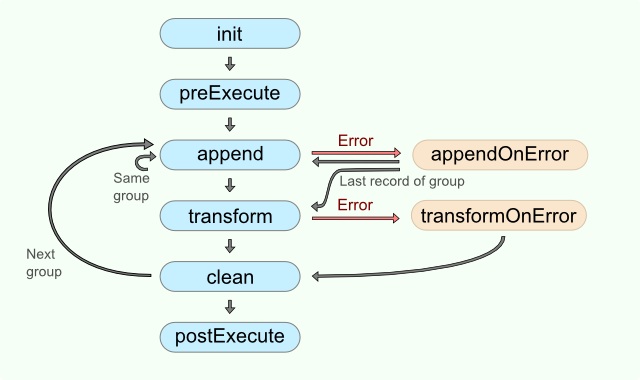Denormalizer
Short Description
Denormalizer creates a single output record from one or more input records. Input records should be sorted.
| COMPONENT | SAME INPUT METADATA | SORTED INPUTS | INPUTS | OUTPUTS | JAVA | CTL | AUTO-PROPAGATED METADATA |
|---|---|---|---|---|---|---|---|
| Denormalizer | - | x | 1 | 0-1 | ✓ | ✓ | x |
Ports
| PORT TYPE | NUMBER | REQUIRED | DESCRIPTION | METADATA |
|---|---|---|---|---|
| Input | 0 | ✓ | For input data records | Any |
| Output | 0 | ✓ | For denormalized data records | Any |
Metadata
Denormalizer does not propagate metadata.
Denormalizer does not have metadata templates.
Denormalizer does not require any specific metadata fields.
Denormalizer Attributes
| ATTRIBUTE | REQ | DESCRIPTION | POSSIBLE VALUES |
|---|---|---|---|
| BASIC | |||
| Key | [1] | A key that creates groups of input data records according to its value. Adjacent input records with the same value of Key are considered to be members of one group. One output record is composed from members of such group. For more information, see Key below. | |
| Group size | [1] | A group may be defined by exact number of its members. E.g. each five records form a single group. The input record count must be a multiple of group size (see Allow incomplete last group). This is mutually exclusive with the key attribute. | a number |
| Denormalize | [2] | Definition of how to denormalize records, written in the graph in CTL or Java. | |
| Denormalize URL | [2] | The name of an external file, including the path, containing the definition of how to denormalize records, written in CTL or Java. | |
| Denormalize class | [2] | The name of an external class defining how records should be normalized. | |
| Equal NULL | By default, records with null values of key fields are considered to be equal. If false, they are considered to be different. | true (default) | false | |
| Denormalize source charset | Encoding of the external file defining the transformation. The default encoding depends on DEFAULT_SOURCE_CODE_CHARSET in defaultProperties. | E.g. UTF-8 | |
| ADVANCED | |||
| Allow incomplete last group | In case input records grouping is specified by the Group size attribute, the number of input records must be a multiple of group size. Using this attribute, this condition can be suppressed. The last group does not need to be complete. | true | false (default) | |
| DEPRECATED | |||
| Sort order | Order in which groups of input records are expected to be sorted. See Sort order below. | Auto (default) | Ascending | Descending | Ignore | |
| Error actions | The definition of an action that should be performed when the specified transformation returns some Error code. See Return Values of Transformations. | ||
| Error log | A URL of the file to which error messages for specified Error actions should be written. If not set, they are written to Console. |
[1] group size has higher priority than key. If neither of these attributes is specified, all records will form a single group.
[2] One of them must specified.
Details
Denormalizer receives sorted data through a single input port, checks Key values and creates one output record from one or more adjacent input records with the same Key value.
Denormalizer requires transformation. The transformation can be defined in CTL (see CTL Interface below) or in Java (see Java Interface below) or using existing .class file (Denormalize class attribute).
To define transformation, use one of the three transformation attributes: Denormalize, Denormalize URL or Denormalize class.
Diagram below describes flow of function calls in Denormalizer.

The function append() is called once for each input record. The function transform() is called once for each group of input records.
If you do not define any of the optional functions init(), preExecute(), clean() or postExecute(), the execution flow continues with the next function according to the diagram.
If you do not specify the appendOnError() or transformOnError() functions and an error occurs, the execution of graph fails.
The transformation uses a CTL template for Denormalizer, implements a RecordDenormalize interface or inherits from a DataRecordDenormalize superclass. The interface methods are listed in CTL Interface and Java Interface below.
Key
Key is expressed as a sequence of field names separated from each other by a semicolon, colon, or pipe.
Example 40. Key for Denormalizer
first_name;last_name
In this Key, first_name and last_name are fields of metadata on input port.
Sort order
If the records are denormalized by the Key, i.e. not by the Group size, the input records must be grouped according to the Key field value. Then, depending on the sorting order of the groups, select the proper Sort order:
- Auto - the sorting order of the groups of input records is guessed from the first two records with different value in the key field, i.e. from the first records of the first two groups.
- Ascending - if the groups of input records with the same key field value(s) are sorted in ascending order.
- Descending - if the groups of input records with the same key field value(s) are sorted in descending order.
- Ignore - if the groups of input records with the same key field value(s) are not sorted.
CTL Interface
The transformation written in CTL uses a CTL template for Denormalizer. Only the functions append() and transform() are mandatory.
Once you have written your transformation, you can also convert it to Java language code by clicking the corresponding button at the upper right corner of the tab.
You can open the transformation definition as another tab of the graph (in addition to the Graph and Source tabs of Graph Editor) by clicking the corresponding button at the upper right corner of the tab.
CTL Templates
| CTL TEMPLATE FUNCTIONS | boolean init() |
|---|---|
| Required | No |
| Description | Initializes the component, sets up the environment and global variables |
| Invocation | Called before processing the first record |
| Returns | true | false if false, graph fails) |
| CTL TEMPLATE FUNCTIONS | integer append() |
|---|---|
| Required | Yes |
| Input Parameters | None |
| Returns | Integer numbers. Negative value lower than -1 aborts processing. Any non-negative value means a successful pass. |
| Invocation | Called repeatedly, once for each input record |
| Description | For the group of adjacent input records with the same Key values, it appends the information from which the resulting output record is composed. If append() fails and the user has not defined any appendOnError(), the whole graph will fail.If any of the input records causes fail of the append() function, and if the user has defined appendOnError() function, processing continues in this appendOnError() at the place where append() failed. The append() passes to the appendOnError() error message and stack trace as arguments. |
| Example | See here below |
function integer append() {
CustomersInGroup++;
myLength = length(errorCustomers);
if(!isInteger($in.0.OneCustomer)) {
errorCustomers = errorCustomers + iif(myLength > 0 ," - ","") + $in.0.OneCustomer;
}
customers = customers + iif(length(customers) > 0 ," - ","") + $in.0.OneCustomer;
groupNo = $in.0.GroupNo;
return OK;
}
| CTL TEMPLATE FUNCTIONS | integer transform() |
|---|---|
| Required | Yes |
| Input Parameters | None |
| Returns | Integer numbers. For detailed information, see Return Values of Transformations. |
| Invocation | Called repeatedly, once for each output record. |
| Description | It creates output records. If transform() fails and the user has not defined any transformOnError(), the whole graph will fail.If any part of the transform() function for some output record causes fail of the transform() function, and if the user has defined the transformOnError() function, processing continues in the transformOnError() at the place where transform() failed.The transformOnError() function gets the information gathered by transform() that was get from previously successfully processed code. Also error message and stack trace are passed to transformOnError(). |
| Example | See here below |
function integer transform() {
$out.0.CustomersInGroup = CustomersInGroup;
$out.0.CustomersOnError = errorCustomers;
$out.0.Customers = customers;
$out.0.GroupNo = groupNo;
return OK;
}
| CTL TEMPLATE FUNCTIONS | void clean() |
|---|---|
| Required | No |
| Input Parameters | None |
| Returns | Void |
| Invocation | Called repeatedly, once for each output record. The clean() function is called after the transform() function. |
| Description | Returns the component to the initial settings. |
| Example | See here below |
function void clean(){
customers = "";
errorCustomers = "";
groupNo = 0;
CustomersInGroup = 0;
}
| CTL TEMPLATE FUNCTIONS | integer appendOnError(string errorMessage, string stackTrace) |
|---|---|
| Required | No |
| Input Parameters | string errorMessagestring stackTrace |
| Returns | Integer numbers. Positive integer numbers are ignored, meaning of 0 and negative values is described in Return Values of Transformations. |
| Invocation | Called if append() throws an exception. |
| Description | The function handles errors which occurred in the append() function.If any of the input records causes fail of the append() function, and if the user has defined the appendOnError() function, processing continues in this appendOnError() at the place where append() failed.The appendOnError() function gets the information gathered by append() that was get from previously successfully processed input records. The error message and stack trace are passed to appendOnError(), as well. |
| Example | See here below |
function integer appendOnError(
string errorMessage,
string stackTrace) {
printErr(errorMessage);
return CustomersInGroup;
}
| CTL TEMPLATE FUNCTIONS | integer transformOnError(Exception exception, stackTrace) |
|---|---|
| Required | No |
| Input Parameters | string errorMessagestring stackTrace |
| Returns | Integer numbers. For detailed information, see Return Values of Transformations. |
| Invocation | Called if transform() throws an exception. |
| Description | The function handles errors which occurred in transform() function.If any part of the transform() function fails, and if the user has defined the transformOnError() function, processing continues in the transformOnError() at the place where transform() failed.The transformOnError() function gets the information gathered by transform() that was get from previously successfully processed code. The error message and stack trace are passed to transformOnError(), as well.The function transformOnError() creates output records. |
| Example | See here below |
function integer transformOnError(
string errorMessage,
string stackTrace) {
$out.0.CustomersInGroup = CustomersInGroup;
$out.0.ErrorFieldForTransform = errorCustomers;
$out.0.CustomersOnError = errorCustomers;
$out.0.Customers = customers;
$out.0.GroupNo = groupNo;
return OK;
}
| CTL TEMPLATE FUNCTIONS | string getMessage() |
|---|---|
| Required | No |
| Description | Prints the error message specified and invoked by the user. |
| Invocation | Called in any time specified by the user (called only when either append(), transform(), appendOnError() or transformOnError() returns value less than or equal to -2). |
| Returns | string |
| CTL TEMPLATE FUNCTIONS | void preExecute() |
|---|---|
| Required | No |
| Input Parameters | None |
| Returns | void |
| Description | May be used to allocate and initialize resources required by the transform. All resources allocated within this function should be released by the postExecute() function. |
| Invocation | Called during each graph run before the transform is executed. |
| CTL TEMPLATE FUNCTIONS | void postExecute() |
|---|---|
| Required | No |
| Input Parameters | None |
| Returns | void |
| Description | Should be used to free any resources allocated within the preExecute() function. |
| Invocation | Called during each graph run after the entire transform was executed. |
Access to input and output fields
Input records or fields
Input records or fields are accessible within the append() and appendOnError() functions only.
Output records or fields
Output records or fields are accessible within the transform() and transformOnError() functions only.
Java Interface
The transformation implements methods of the RecordDenormalize interface and inherits other common methods from the Transform interface. See Common Java Interfaces.
Following are the methods of the RecordDenormalize interface:
boolean init(Properties parameters, DataRecordMetadata sourceMetadata, DataRecordMetadata targetMetadata)
Initializes denormalize class/function. This method is called only once at the beginning of denormalization process. Any object allocation/initialization should happen here.int append(DataRecord inRecord)
Passes one input record to the composing class.int appendOnError(Exception exception, DataRecord inRecord)
Passes one input record to the composing class. Called only if append(DataRecord) throws an exception.int transform(DataRecord outRecord)
Retrieves composed output record. For detailed information about return values and their meaning, see Return Values of Transformations. In Denormalizer, only ALL, 0, SKIP, and Error codes have some meaning.int transformOnError(Exception exception, DataRecord outRecord)
Retrieves composed output record. Called only if transform(DataRecord) throws an exception.void clean()
Finalizes current round/clean after current round. Called after the transform method was called for the input record.
Examples
Converting multiple having same key records to one
Input records acquired from relational database contain fields companyName and product.
Denormalizer Limited |chocolate
Denormalizer Limited |coffee
Denormalizer Limited |pizza
ZXCV International |coffee
Convert the records to following form: companyName is followed by list of products separated by commas.
Solution
Use the Key and Normalize attributes.
| ATTRIBUTE | VALUE |
|---|---|
| Key | companyName |
| Normalize | See the code below |
//#CTL2
string[] products;
string companyName;
function integer append() {
append(products, $in.0.product);
companyName = $in.0.companyName;
return OK;
}
function integer transform() {
$out.0.companyName = companyName;
$out.0.products = join(",", products);
return OK;
}
function void clean() {
clear(products);
}
Denormalizer returns following records:
Denormalizer Limited |chocolate,coffee,pizza
ZXCV International |coffee

Records with the same Key have to be available in input data all at once. Otherwise you will get a new output record for each several subsequent records having the same key.
The best solution is to have input records sorted by Key.
Converting fixed number of records to one records
Given a list of students.
Charlie
Daniel
Agatha
Henry
Oscar
Kate
Romeo
Jane
Convert the list to groups of 3. Each group (one output record) has a number and names of its members. The names are separated by comma.
Each output record contains groupNumber and members.
Solution
Use the Group size and Normalize attributes. To be able to process the number of record not being divisible by 3, you need the Allow incomplete last group attribute.
| ATTRIBUTE | VALUE |
|---|---|
| Group size | 3 |
| Normalize | See the code below |
| Allow incomplete last group | true |
//#CTL2
integer groupNumber;
string[] names;
function integer append() {
append(names, $in.0.name);
return OK;
}
function integer transform() {
$out.0.groupNo = groupNumber;
$out.0.members = join(",", names);
groupNumber++;
return OK;
}
function boolean init() {
groupNumber = 1;
return true;
}
function void clean() {
clear(names);
}
Denormalizer returns following records:
1|Charlie,Daniel,Agatha
2|Henry,Oscar,Kate
3|Romeo,Jane
Best Practices
If the transformation is specified in an external file (with Denormalize URL), we recommend users to explicitly specify Denormalize source charset.
See also
Normalizer
Rollup
Common Properties of Components
Specific attribute types
Common Properties of Transformers
Updated about 1 year ago

